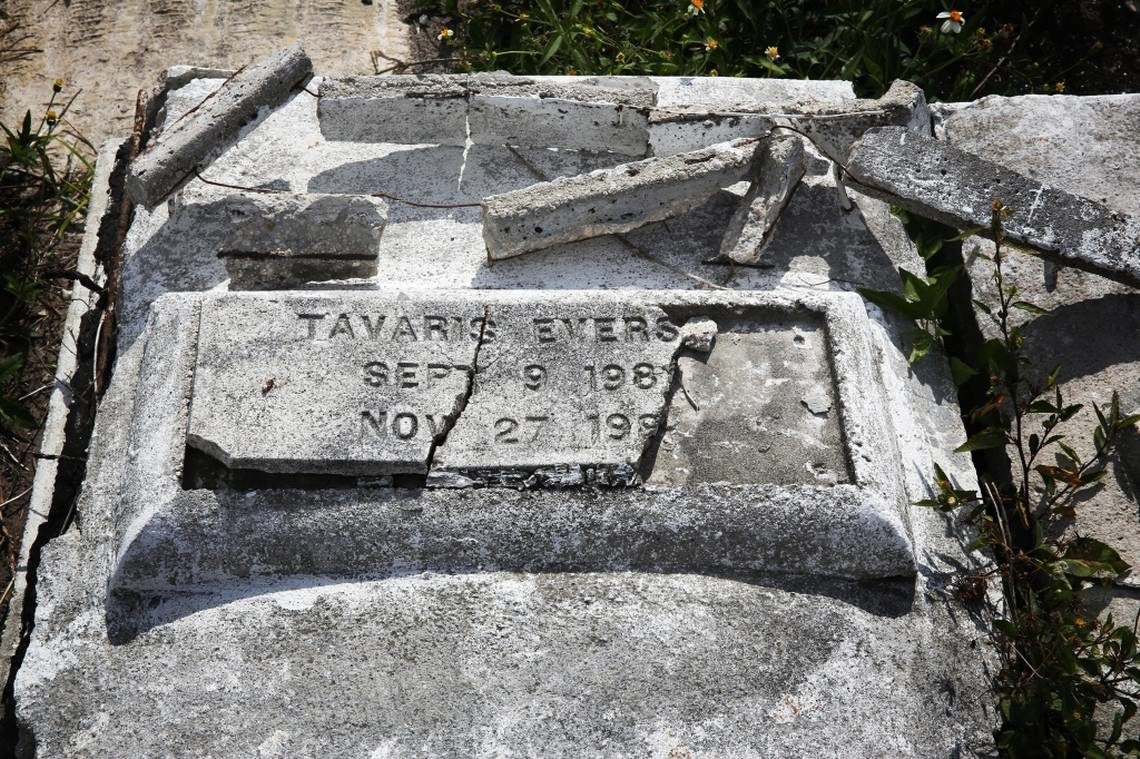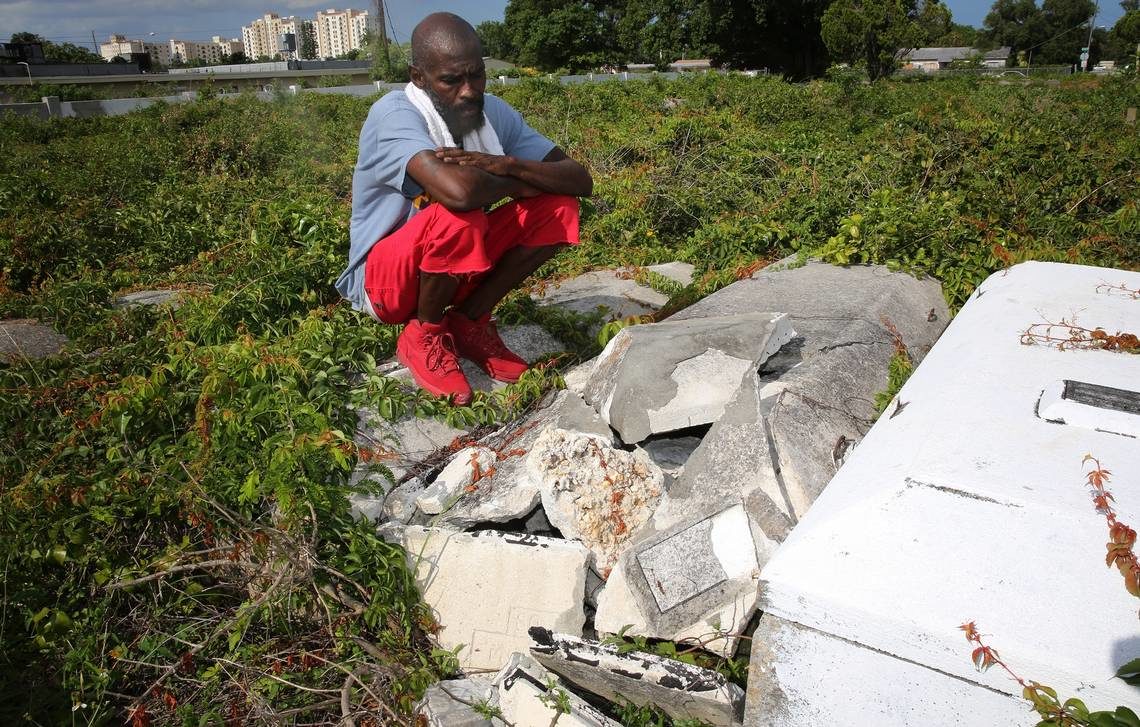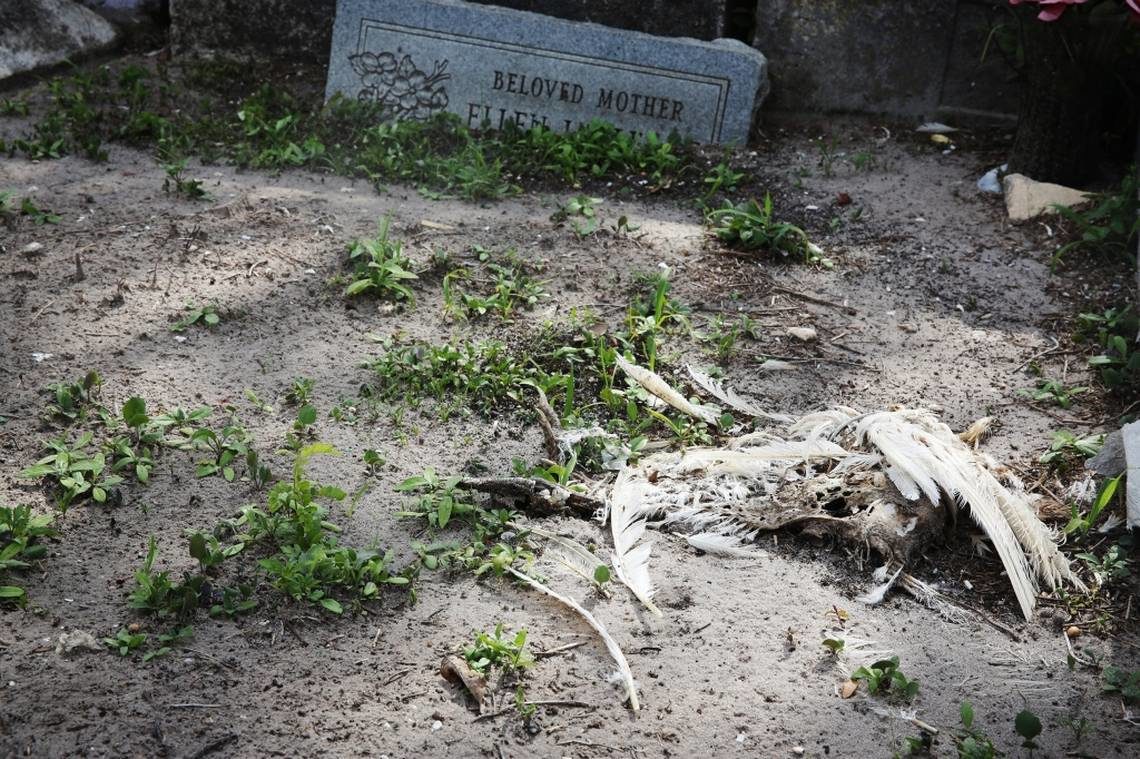
"No, that's a leg bone. See where the foot used to be?" said Arthur Kennedy, bending down to take a closer look at the smooth, brown, contoured tibia.
Kennedy would know. He's not a forensic scientist but he is a cemetery caretaker - who lives in the middle of a cemetery - and he's recently seen more bones than he cares to remember.
"Here's his belt," Kennedy said, pointing to a rotting black strap hanging off the side, a remnant of the dignity of the dead man when he was buried in his Sunday best.
He rests in peace no more. The one bone is all that's left of the dearly departed. His remains were likely stolen by grave robbers who use human bones in religious ceremonies or sell them on the black market.
"There's a lot of witchcraft going on, and I've been offered $1,000 for a skull," Kennedy said. "It's inhumane how they're attacking the dead and dismantling the graves. Our history is buried in these cemeteries."
A rash of vandalism and an increase in trespassing at three of Miami's oldest cemeteries has not only disturbed the repose of the deceased but complicated the struggle of protecting and preserving historic sites that have been neglected for years.
At Lincoln Memorial Park, burial place of some of Miami's most prominent black leaders, three graves - including one of a child - were broken into and ransacked two months ago.
Kennedy, who lives in the small office at the center of the 10-acre Lincoln property in Brownsville, nightly chases away drug addicts, homeless people, prostitutes, vandals, bone burglars and Santeria worshipers who deposit offerings of slain chickens, fruit, candy, cigars and coins.
"I got shot once. Guy pulled a gun on me when I told him to get out," said Kennedy, rolling up his shorts to show a scar on his thigh. "I might pick up 18 chickens in one day. I've picked up a boar's head, a dead monkey, dead rabbits, apples, a birthday cake. We got some serious voodoo and hocus pocus out here."

Lincoln became unkempt and overgrown under previous owner Elyn Johnson as she succumbed to Alzheimer's disease. Her niece Jessica Williams took over and hired Kennedy to keep watch, clear the weeds and repair graves, many of which are missing their nameplates and can't be identified.
"This one they smashed open with a sledgehammer," Kennedy said, showing the cracked shards of a vault he hasn't been able to fix. Nearby, white chicken feathers sit by a headstone.
Across town at the Miami City Cemetery - final resting place of pioneer Julia Tuttle, the Burdine, Peacock, Jackson, Seybold and Belcher families, war veterans and some 9,000 others - Ronnie Hurwitz tells a homeless man sleeping on plastic garbage bags that it's time to leave because he is locking up for the night.
Hurwitz, cemetery guardian, historian and tireless volunteer for 30 years who has meticulously restored hundreds of gravesites, said other homeless people use the place "as a laundromat, hanging wet clothes on headstones to dry."
The cemetery, which dates back to 1897 when Mary Brickell sold the land to the city, is in much better shape since a 1997 task force was formed to reverse its decline, but lately Hurwitz has found more toppled headstones and more religious offerings. Thieves also steal the American flags he places at soldiers' graves.

Heroin addicts have replaced the crack addicts who stole bronze plaques in the 1980s.
"They broke the doors into a mausoleum and were shooting up and sleeping in there. I found 25 needles on the floor," said Hurwitz, pointing to the Vereen family crypt that has been boarded up with plywood.
But the cemetery that has suffered the most abuse is Evergreen Memorial Park, another predominantly black graveyard that is located five blocks from Lincoln and right next to the 112 expressway. It opened in 1913, ten years before Lincoln.
About 20 graves have been opened within the past month and most are missing their remains. Vandals used a crowbar to lift the vaults' slab covers and then pried open coffins made of wood or metal. Within Evergreen there were coffins immersed in two feet of rainwater, tipped over or busted into pieces. A half-dozen blue plastic gloves were discarded around graves that held a man born in 1918 who died in 1994 and a woman born in 1915 who died in 1966.
Evergreen, which was bought out of foreclosure by the Reeves family that owns the Miami Times - the city's first black newspaper - has had little upkeep or security. Trees downed by Hurricane Irma have not been removed. Kennedy and Williams walk over on occasion to patrol and are appalled by what they see.
"You'd think Evergreen was a homeless shelter. They're not zombies, they're just resting," Kennedy said. "It's saturated with drug addicts getting high in the graveyard. People have sex right on top of the vaults. Prostitutes need a quick trick. Cemetery porn. It's crazy."
Williams can't tolerate the lack of reverence for the dead. Evergreen is a lonely place with few visitors.
"What goes on is not appropriate for a graveyard," she said. "It gives me the creeps. If the right relatives ever show up it's going to get ugly."
Kennedy's grandfather is buried on the west side, near the headstone of an Air Force veteran where someone left three purple eggplants and a cardboard box with animal bones in it. Kennedy kicked a bulging plastic bag and a swarm of flies emerged.
"Carcass of some kind," he said, covering his nose.
The offerings to orishas may very well come from Santeria followers, but who is collecting the bones? Santero priests do not use human bones in their ceremonies, but practitioners of Haitian vodou and an Afro-Cuban religion called Palo Mayombe perform rituals with bones, said anthropologist and author Mercedes Sandoval, professor emeritus at Miami Dade College.
"Santeria has nothing to do with human bones but in Palo Mayombe and vodou they do work with human remains," Sandoval said. "Palo Mayombe originated in a different part of Africa, in the Congo, and has its own priesthood and rules. They are looking for spiritual forces in the dead. They believe in making a pact with the dead. They used to buy skulls from places where they sold things for medical students.
"From the outside it may look like a lack of respect for the family but they are not doing it to show disrespect."
Santeria offerings are an appeal to the gods, which represent archetypal forces of nature, for help in solving problems, such as health or financial problems, Sandoval said.
"People who attribute all these practices to Santeria are ill-informed," she said. "Remember, offerings and magic are found in every culture of the world."
Palo priests are known to be secretive because they think their religion is misunderstood as black magic, but they do acknowledge that they believe bones contain the energy of the dead and ancestors. Bones are placed in an altar-like cauldron or prenda or nganga with sticks, knives or machetes and dedicated to a spirit or mpungu.
Williams said she once found a large kettle with a skull and sticks inside on the Lincoln grounds.
Palo followers have been linked to grave looting in Caracas, Venezuela, where skulls were selling for $2,000 and femurs for $450. A Connecticut man who said he was a palero was arrested for stealing bones from two mausoleums in Worcester, Mass. A New Jersey practitioner was arrested when police found human remains in pots in his basement. And a Palo priest in Miami was arrested when police found human bones at his home as well as dead and frozen animals and powder made from the animals that he was selling.
"There's a black market for everything," Hurwitz said.
While Hurwitz and Kennedy lament that they cannot catch every intruder, they are receiving help from members of the Florida Public Archaeology Network, who responded to the grave break-ins by filing police reports, repairing some of the damage and covering exposed coffins with tarps.
"When you destroy cemeteries you destroy the past," said Mallory Fenn, FPAN's public archaeology coordinator. They held a preservation workshop with the Dade Heritage Trust at the city cemetery in May. "We want to raise awareness so that people will value cemeteries as public museums."
The Coral Gables Museum has been working with Williams and Kennedy on restoration at Lincoln, including cleanup of crypts and research of old funeral home records to identify who is buried where so descendants can find their relatives. The museum, which is planning an exhibit about Lincoln, is examining the books of Kelsey Leroy Pharr, the former owner, undertaker and civil rights activist who used to take down the bodies of lynching victims and gave them a proper burial at Lincoln.
He also changed a discriminatory policy that denied a reserved plot to a black resident if he or she failed to pay if off before dying, which meant "the community was oppressed even in death," said Malcolm Lauredo, the museum's director of historical research.
"Under Pharr, Lincoln was known as the finest cemetery in the South," Lauredo said. "We've invested in its future."
Miami architect Jorge Kuperman would like to design a new fence and secure historical designation for the entrance archway.
"It could look a lot better," he said. "We want to make sure it is preserved and protected."
Kennedy, a native son of the neighborhood whose mother was a police officer and whose father was a pimp, will remain on the lookout for decapitated chickens, meth heads, grave robbers and anybody else who treats a cemetery like a dead zone.
"I feel a spiritual connection to the people buried in these plots. Every single one has a story," he said. "A hundred years from now we'll all be dead, but this cemetery needs to be here so we're not forgotten."



Comment: